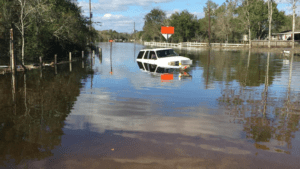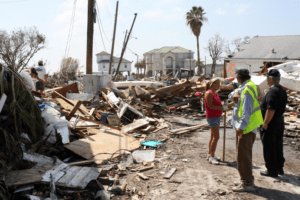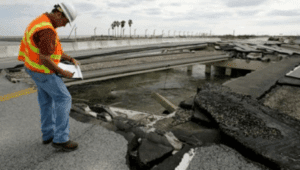We’re your Disaster Recovery Partner
Disaster Strikes
2005 brought Hurricane Rita to Texas’ Gulf Coast causing complete devastation of homes, businesses, and vital infrastructure. In response to Hurricane Rita, Texas received funding allocations totaling $500+million that served over 1.8 million people through recovery projects and programs [source: Texas GLO].
Then, in 2008, Hurricane Ike hit the Gulf Coast and caused $29.5 billion in property damage and over $140 billion in economic loss, becoming the third most devastating hurricane in U.S. history. Ike’s damage added to that caused by Hurricane Rita, as the two disasters impacted the same counties [source: Texas GLO]. In response to Ike, $3.1 billion in federal aid was eventually allocated to Texas by the Department of Housing and Urban Development [source: NY Times].
After Rita and Ike, people along the Texas Gulf Coast wanted to rebuild homes, clean up neighborhoods, repair their communities – they wanted to return to normal. But, with flooded roads and municipal buildings without power, where did local officials begin? How were they going to get their share of the emergency funds?
Hurricane Ike, Source: National Geographic
Applying for recovery grant money is a complicated process and when you’re riddled with worry about ensuring your constituents stay safe, it’s hard to wrap your head around the paperwork, site-assessments and other steps that need to be taken.
Even after your region is allotted emergency funds, actually receiving the funds can be a disaster in itself. Your money could be delayed because of federal bureaucracy and regulations, along with paperwork and policies in state and local agencies, and even due to the fact that Texas suffers more major disasters than any other state, from hurricanes and wildfires to drought and floods, frequently occurring within the same year. “Since 1953, Texas had more major disaster declarations then every other state,” said Nim Kidd, the state’s emergency management director [source: Houston Chronicle].
We’ll Be There
SPI has been there and come out on the other side of the disaster recovery process. We’re disaster relief professionals and our engineering team has extensive experience working with all types of funding programs and their requirements. We have helped our clients with loans and/or grants from funding agencies, such as: Texas General Land Office (GLO) – Disaster Recovery Fund Grants, Texas Department of Agriculture (TDA) – Texas CDB Grants, TWDB – State Revolving Fund – (Clean Water and Drinking Water SRF), TWDB – Rural Water Assistance Fund (RWAF – Drinking Water), Federal Emergency Management Agency – (FEMA) and local banks.
SPI Engineers working on a project for the City of Terrell
After Hurricanes Rita and Ike, city leaders from affected East Texas areas – Orange County, Montgomery County, Liberty County – turned to us for guidance in pursuing funding for critical infrastructure that failed during the storms. With offices in Houston, Beaumont and other East Texas areas, we were compelled to help – these were our people. While staying responsive to the communities’ needs and in constant communication with their officials, we worked with relief agencies to secure loans and grants for their recovery.
We’ve Done This Before
After Hurricane Ike’s destruction in 2008, we helped Cherokee and Nacogdoches County wade through the emergency funding process and then we advised them on forming a plan to use the funds effectively. We were involved throughout the entire journey, from preparing grant application documents to overseeing the installation of emergency generators at water treatment plants, wastewater lift stations, and emergency shelters in municipalities and water supply corporations throughout these counties. Texas cities that benefited from these efforts included Jacksonville, Rusk, Alto, Cuney, Lilbert-Looneyville WSC, Cushing, Sacul WSC, Swift WSC, Melrose WSC, and Oakland-Dialville WSC.
Hurricane Ike’s damage in Jacksonville, TX, Source: Jacksonville Progress
In West Orange, we helped the City with several disaster recovery projects including the rehabilitation of 27 damaged roads, replacement of two major culvert crossings, installation of generators at the police and fire stations, and demolition of approximately 20 residential structures damaged by the hurricane and condemned by the City.
Liberty County needed extensive road repair, and we helped with the rebuilding and re-routing of Nueces Road (CR 2231). This projecte involved the relocation of the County Road away from the Trinity River in order to prevent further erosion and inundations. The project included the complete rebuild of the roadway and all associated drainage infrastructure.
Trinity River Flooding in Liberty County, Source: ABC 13
Different areas of Montgomery County were also affected by Hurricane Ike. We provided engineering design and construction administration services for improvements to the Dearwood neighborhood and Highline Boulevard drainage systems, including replacing highway culverts, approximately 35 driveway culverts, and improving 63,000 linear feet of roadside drainage ditch.
How We’ll Help
Galveston after Hurricane Ike, Source: FEMA
We believe that successful disaster recovery projects are achieved through sound engineering practices, cost effective design, and great communication between SPI, the client, and the funding agency. We’ll be there to conduct site visits, to assess infrastructure damage and to help with documentation, such as project descriptions, site location maps, project cost estimates and photo documentation. We are proud to offer the following services to help you:
Design, Construction Administration and Construction Representation for:
Surface Water Treatment Facilities
Groundwater Development and Production
High Service Pump Stations
Water Distribution Systems
Wastewater Treatment Facilities
Emergency Generators
Solids Management Facilities
Lift Stations
Wastewater Collection Systems
Drainage Infrastructure Improvements
Road and Bridge Improvements
Emergency Shelters and Facilities
If you’ve been working with local municipalities on debris removal; clearing and grading of ditches, channels and drainage structures; streets, storm sewer, utilities and other infrastructure repair, we can also advise you on how to receive fair reimbursement from agencies such as FEMA for these expenditures.
Conclusion
Survey of bridge damage after Hurricane Ike, Source: Austin American Statesman
We know that rebuilding after a natural disaster is not an easy process. We’re not promising to return things to normal, but we will promise to combine our experience and skills to help you receive the maximum amount of emergency funding and to be by your side as you start building for the future.
Jerry Pickard – General Manager, G-M Water Supply Corporation – said this about working with us, “SPI assisted us with navigating multiple funding sources for loans and grant money, as well as all Federal and State Agency coordination for all project review and approval processes. SPI provided quality work in a responsive manner from project conception through the completion of construction. We would highly recommend SPI.”
We’ve been around since 1937 and with offices in Beaumont, Houston, Terrell and Tyler, our Texas roots run deep and we’re always going to be there for our neighbors. Give us a call, and we’ll be happy to answer any of your questions about natural disaster funding and rebuilding.






